Why not take a late summer break on one of Spain’s (almost) secret islands?
From the Canaries to Galicia, Spain has a surprising number of islands, deserted and otherwise

When the late summer heat kicks in, it’s hard not to daydream about laying out on an island shore. Due to their ecosystems and biodiversity, there is limited access to many of the islands around Spain. But that makes the desire to visit these unspoiled nature reserves even greater.
Each island is its own separate universe, each with its own defining characteristics and exciting activities. Here are 11 paradises just a short boat ride from the mainland for those seeking a more secluded and sustainable form of tourism.
1. Lobos Island (La Oliva, Fuerteventura)
This natural park is one of the many gems of the Canary Islands. You can catch a boat from Corralejo, a town on Fuerteventura. It’s advisable to wear a hat and take plenty of water for the 20-minute journey to this pristine island.
The island can be walked around in about three hours, following the rise and fall of the Caldera Mountain that sits atop the entirety of the island. Along the way you’ll see the Martiño lighthouse and you can eat at El Puertito, the seafood restaurant owned by the son of the last lighthouse keeper in Lobos. After lunch, go diving from La Concha beach, where roman artifacts have been excavated. For a more relaxed itinerary, on the days when the heat makes hiking seem more like a chore, spend your day swimming in the unbelievably blue waters of the Lagunitas wetlands. End your day at La Concha beach, where you’ll be just a six-minute walk to your boat ride back to Corralejo, where you can continue your island vacation.
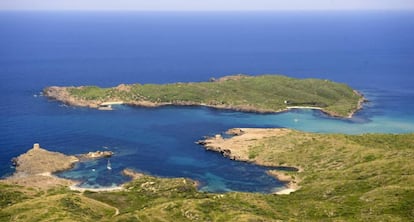
2. Colom Island (Mahón, Menorca)
Looking for an escape? This tiny island has somehow escaped the fame of Menorca, only 500 meters away. Home to the Albufera des Grau national park, this island’s ecosystem is so protected and pristine that swimmers aren’t allowed to leave the beaches, not that the thick maze of vegetation surrounding the beach would be easy to get through anyway.
You can catch a ride to this deserted island, which was once home to a quarantine station for former slaves escaping Algiers, from the port town of Es Grau, Menorca. For visitors looking for more adventure, grab some rental kayaks on the main island to paddle across and take in the views of the island on the way. While Colom’s sandy beaches make up a small part of the island, they are within small coves so from the shore you get beautiful views of dramatic rocky cliffs with lush vegetation. Since the beaches face west, stay on the island until dusk for a scenic sunset over the water.
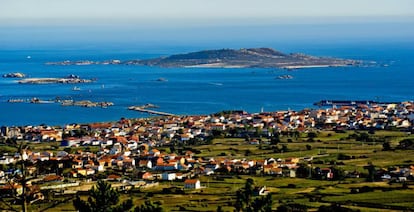
3. Sálvora Island (Ribeira, A Coruña)
The high numbers of tourists that head to the Cíes Islands each year makes us turn our attention to one of the less-frequented islands off the northern coast of Galicia. Sálvora’s beauty is unspoiled due to the fact that it was privately owned until 2008, but you can now set foot on the island with a guide. Sail 40 minutes from the shores of O Grove in Galicia to visit Sálvora’s white sands and picturesque village. If a speedboat is more your style, you can reach the island in just 10 minutes.
Your first stop should be the lighthouse that was erected after the Santa Isabel shipwreck in 1921, known as “The Galician Titanic.” The lighthouse stands atop a cliff that has great views of the rocky shores of the island. Next, head to the quaint village made up of old stone houses. The standout is the pazo, a traditional Galician aristocratic country house. Legend says Sálvora’s pazo was built atop an old salting factory. From the village, you can see horses grazing in the fields, redolent of an earlier time.
4. Graciosa Island (Teguise, Lanzarote)
Anyone who is a fan of islands knows that the Canary Islands are synonymous with beauty. The island of Graciosa is no exception, with its 30 kilometers of shoreline. The island is mostly flat with the exception of the four hills created by volcanic activity. Leaving from the port in Órzola on the larger Lanzarote Island, you can reach the island in 20 minutes. Once you dock in Caleta del Sebo you can decide how you want to spend your day.
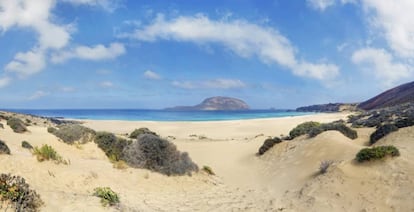
Any trip to Graciosa Island would be remiss without visiting Conchas Beach, named aptly after the shells that make up its sandy shores. The water is constantly changing between various shades of blue. The crystal waters may be enticing, but swim at your own risk because these waters are known to be dangerous. If you’re looking to spend more time in the water, head to Cocina Beach for some of the best swimming on the island. To get there, you need to cross Francesa Beach and walk for about 20 minutes, but it’s well worth the journey. If being on land is more your speed, there’s a 15-kilometer cycling route organized by El Mato Bikes that takes you for a scenic tour of the island. Once you work up an appetite, try the tradition fish stew, el marinero, or the sailor.
5. Espalmador Island (Formentera)
From the busy island of Formentera, you can catch a boat to a calm, peaceful paradise. Leaving from La Savina, your ride will take you to the private island of Espalmador. Daily visitors must exclusively stay on the shores, but with its soft sand and transparent waters, you won’t want to leave this beach, whether your floating in the water or sitting in the sand watching the yachts go by.

We advise staying away from the mud baths, since they are unhygienic. But if you find yourself looking for something to do, take a walk down the beach to check out the old watchtower as you walk by Sa Torreta Beach. Once you reach the end of the island, you’ll be glad you made the trek. The view of the lighthouse on the neighboring En Pou Island is magnificent.
6. Ízaro Island (Bermeo, Biscay)
Legend has it that the northern costal towns of Bermeo and Mundaka settled their eternal rivalry over who owns Ízaro Island with a race at dawn. Bermeo cheated and got a head start, but in the end Mundaka was victorious. This island’s interesting history is still cherished today.
Ízaro is a protected ecosystem so you can’t actually set foot on the island. However, a boat, leaving from Bermeo, makes a daily journey around the island so you can observe its beauty close up and take in the striking rugged mountain spine that runs across the whole island. From the boat you can also see the ruins of a monastery, from one of the island’s sporadic periods of human occupation. Uniquely, a gas station in Mundaka has another one of the best views of the island. The movie distributor Ízaro Films took an photo at this very spot to use for its promotional materials.
7. Medes Islands (Torroella de Montgrí, Girona)
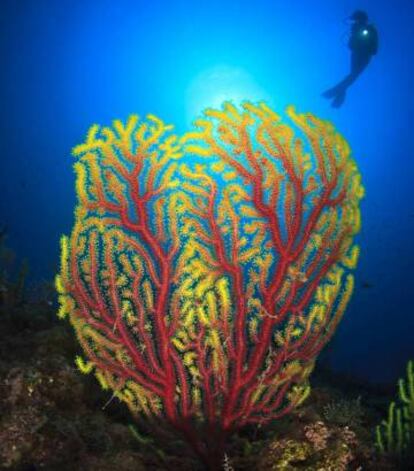
The seven Medes Islands have been under environmental protections for three decades to preserve their unique underwater ecosystem. For anyone fascinated by life underwater, the Medes archipelago makes for the perfect vacation.
These islands are home to some of the best snorkeling and scuba diving. With a pair of goggles and fins, the whole family can see a variety of sea life, including fan mussels and, most notably, salps, a unique transparent underwater creature. For people looking to do a deep dive, expect to see grouper fish, gorgonian coral, and moonfish. If you prefer to stay above water, the islands are a great place to try out paddle boarding, sailing, or kayaking. All of these activities can be done with the incredible Montgrí cliffs as a backdrop.
8. Sancti-Petri Island (Chiclana de la Frontera, Cádiz)
This next island is not simply notable for its beauty, but for its rich history. Sancti-Petri Island is home to the Sancti-Petri Castle, built in the 17th century. The castle was built over the remains of a Phoenician temple dedicated to the god Melqart. It is also where the Romans believe Hercules was buried. Located one kilometer from the coast of Cádiz, a city on the southwestern coast of Spain, Sancti-Petri is an island of ancient walls and historic significance.
You can reach the island by boat or kayak. Don’t worry about overexerting yourself, the thrust of the tide will help push your kayak right along to the shores of Sancti-Petri. For those more interested in the arts, actors dress up as “romanceros,” or traditional storytellers from the Cádiz Carnival, to tell the story of the island. Besides its history, the island itself is a beauty deserving of a visit. Come for sunset for some incredible views.
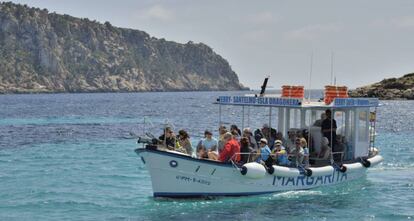
9. Dragonera Island (Andratx, Mallorca)
Mallorca’s reputation of a calm, quiet island no longer seems to apply as more and more visitors come to the Mediterranean island. Dragonera Island has since taken over that status. In 1977, a group of activists occupied the island to protest its urbanization. Since then, the island has remained a natural beauty.
This uninhabited island is 2.7 kilometers from San Telmo on Mallorca. The first ferry to the island is at 9.50am. There are a few ways you can spend your time on Dragonera. The mountainous island obviously provides some amazing views. Hike 12 kilometers to the Na Pòpia summit where the old Llebeig lighthouse stands for the best view of the island. This summit is also a great place to view hawks hunting for their offspring in September and October. However, keep in mind the trek is a challenging one so it’s best not to hike it in July or August, or at least come prepared with plenty of water and a hat. The Tramuntana is the island’s functioning lighthouse, and also a museum about island lighthouses. By 5.00pm, everyone is expected to board the ferry back to Mallorca.

10. Benidorm Island (Alicante)
From afar, this island merely looks like a slanted slab of rock floating in the Mediterranean, but its dramatic cliff is just one of the interesting things to see on this island. The island is 3.5 kilometers from the coast of Benidorm in Alicante.
There are a few unique ways to get to Benidorm Island. You can take a large ship, a glass-bottomed boat, jet-ski, or even a kayak. Once you get on the island, one of the most interesting things to do is to get right back on an aquatic vehicle, although this time a submarine. The Aquascope III can take you to the sea floor for an incredible view of marine life. If you want to get more up close and personal with the fish, consider scuba diving. The island’s cliff is also home to some unique animal life, a European peacock colony. La Caleta Beach is another stop on the island to add to your list. Here you can grab some food on the island bar and restaurant and followed by some snorkeling close to shore.
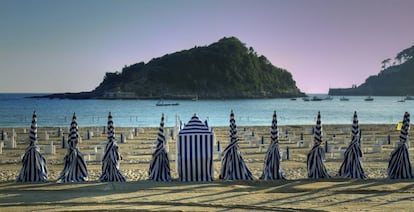
11. Santa Clara Island (San Sebastián, Gipuzkoa)
One of the greenest islands on this list is Santa Clara Island, off the coast of the northern city of San Sebastián. A small ferry or kayak can take you out to the island or if you’re a strong swimmer and up for the challenge, you can swim to the island. It’s a distance of about 400 meters from the bar on Santa Clara to Ondarreta Beach. From Concha beach, the distance is about 1,130 meters, but there are floating rest stops along the way.
If you’ve worked up an appetite swimming to the island, there are plenty of food options on Santa Clara. As you follow the path up the island’s cliff, you’ll find many picnic tables shaded by tamarind trees to enjoy your meal. At the top of the cliff sits a unique square lighthouse unlike any other you’ve seen.
English version by Debora Almeida.
Tu suscripción se está usando en otro dispositivo
¿Quieres añadir otro usuario a tu suscripción?
Si continúas leyendo en este dispositivo, no se podrá leer en el otro.
FlechaTu suscripción se está usando en otro dispositivo y solo puedes acceder a EL PAÍS desde un dispositivo a la vez.
Si quieres compartir tu cuenta, cambia tu suscripción a la modalidad Premium, así podrás añadir otro usuario. Cada uno accederá con su propia cuenta de email, lo que os permitirá personalizar vuestra experiencia en EL PAÍS.
¿Tienes una suscripción de empresa? Accede aquí para contratar más cuentas.
En el caso de no saber quién está usando tu cuenta, te recomendamos cambiar tu contraseña aquí.
Si decides continuar compartiendo tu cuenta, este mensaje se mostrará en tu dispositivo y en el de la otra persona que está usando tu cuenta de forma indefinida, afectando a tu experiencia de lectura. Puedes consultar aquí los términos y condiciones de la suscripción digital.










































